Judi Lynn
Judi Lynn's JournalArgentina ready to supply gas to Europe via Spain
jn/kb 11.05.2022, 20:24
Argentina announced on Tuesday it was ready to create a joint venture with Spain to supply gas to Europe, which is seeking to become independent from Russia’s energy due to the country’s aggression against Ukraine.
Argentinian President Alberto Fernández said after a discussion with Spanish Prime Minister Pedro Sánchez on Tuesday that Argentina had a perfect synergy with Spain to ease the crisis caused by Russia and was ready to become a stable energy supplier to Europe.
As the second largest producer of unconventional gas in the world, Argentina could supply liquified gas to Spain, which has 30 percent of the plants that regasify liquefied gas. The liquified gas would be then turned into natural gas and distributed from Spain to the rest of Europe.
The plan comes in response to European efforts to cut off Russian gas imports in order to stop the indirect funding of Russia’s invasion of Ukraine.
https://tvpworld.com/60127386/argentina-ready-to-supply-gas-to-europe-via-spain
MUSA Underwater Museum of Art in Cancun: Dive Into Art in Isla Mujeres, Mexico
INTERNATIONAL 3 hours
Sheri B Doyle

In the beautiful waters of Isla Mujeres, Mexico, an underwater museum was built nine years ago in an effort to create a sustainable reef-like structure for ocean life. When I saw the MUSA online, I decided I had to dive it.
Once I was underwater, the sculptures were more breathtaking than I had even imagined. Our path first took us to a man working at a desk, complete with a desk phone, paperwork and a friendly-looking dog sitting at his feet. Each detail was perfect on the life-size objects. Next, we swam past a sculpture of an original VW bus and then on to what was the piece de resistance – a collection of 450 life-size sculptures of humans.

Photo: MusaMexico.org
Approaching the exhibit I was taken aback by the volume of statues occupying the 420-square-meter area. Moving closer, the detail on each face brought them to life. There was emotion visible in their expressions and features. It was breathtaking.

Photo: AquaWorld.com
Beautiful pink and purple corals had taken root on the statues' bodies and faces, enhancing the effect of the statues standing together, as if they were migrating to another place. Each statue was modeled after a real person the artist had pose for him. After swimming among the statues, it is truly remarkable how he captured their essence.

Photo: AquaWorld
Article:
https://30seconds.com/travel/tip/17450/MUSA-Underwater-Museum-of-Art-in-Cancun-Dive-Into-Art-in-Isla-Mujeres-Mexico#_=_
(Look for the link under the last photo, the VW Bug to go to "The Silent Evolution of MUSA
September 19, 2016
Diving Articles, Musa" )
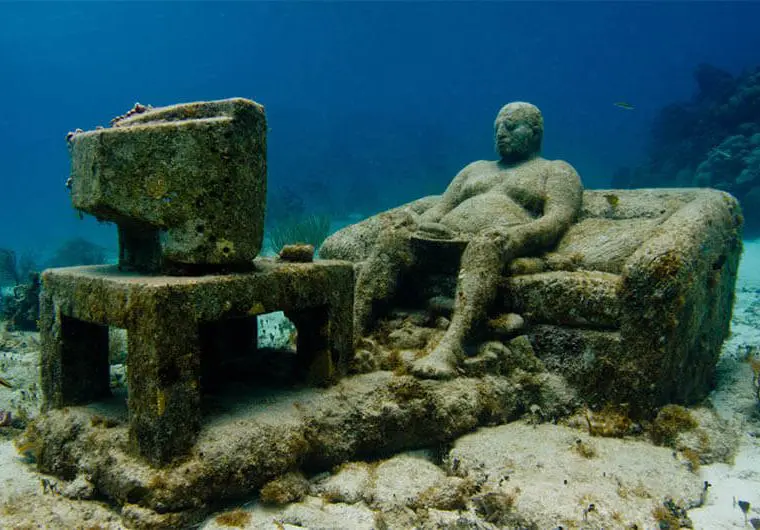



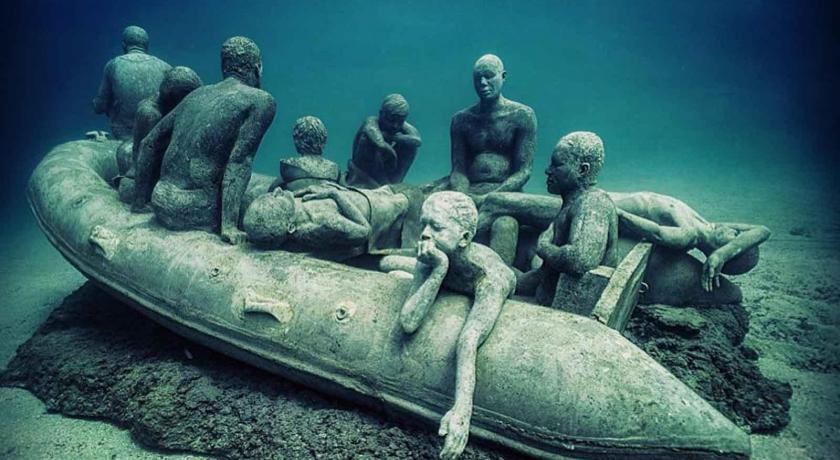



In Brazil, Politicians Push to Privatize Beaches

In Brazil, beaches are used by a broad swath of society. A new bill, however, looks set to restrict beach access in favor of tourism development. Photo by BrazilPhotos/Alamy Stock Photo
A new bill that would open a huge chunk of Brazil’s coast to tourism development could have far-reaching consequences.
by Eduardo Campos Lima
May 11, 2022 | 600 words, about 3 minutes
Brazilian politicians with connections to the tourism and hospitality industries are pushing forward a bill that would privatize parts of the country’s beaches. Known as bill 4444/2021, the legislation, proposed by Congressman Isnaldo Bulhões Jr., is ostensibly designed to make the management of federal properties across the country more efficient. The bill sets out a plan to identify and catalog all lands and public buildings and examine who is occupying them, how they are being used, and whether users are paying the appropriate fees. In cases in which non-federal-government users—other branches of government or private users—occupy the land and buildings, the estate will revert back to the federal government.
But nestled within the bill’s text is a controversial provision that gives the government the power to create so-called special zones of tourism use. These zones would convert public beaches—up to 10 percent of the sand strip in a city—to private property, barring access to unauthorized people and opening the beaches up to development by hotels, private parks, clubs, marinas, and other endeavors allowed by Brazil’s Ministry of Tourism.
Though the bill was first put forth in 2021, in February it was deemed an urgent proposition by Brazil’s Chamber of Deputies, a lower house in the country’s National Congress. The move could see it go to a vote imminently. The urgent classification could also exempt the bill from otherwise mandatory stages, such as public consultation.
Congressman Rodrigo Agostinho, a longtime environmental activist, says the bill shows the pressure being exerted on congresspeople by the gaming industry. Earlier this year, Brazil’s Chamber of Deputies pushed games of chance closer to legalization. “Many companies that own casinos want to build them by the sea,” he says.
More:
https://hakaimagazine.com/news/in-brazil-politicians-push-to-privatize-beaches/
TACOS AS CULTURAL RESISTANCE: OAXACA'S MIXE INDIGENOUS COMMUNITY POWER L.A.'S AL PASTOR SCENE
TODILIA ROMERO·MAY 10, 2022
In California and several other states and cities in the United States, we Indigenous people Specifically, Zapotec and Mixtec, from the state of Oaxaca, Mexico, make their way to the streets of Los Angeles.
Many of us who grew up eating tortillas and chiles daily found our calling in becoming taqueros and taqueras here.
On the border with Mexico, in Southern California, and the Central Valley, it is common to identify areas and neighborhoods where our presence is becoming more noticeable and visible day after day. In these cities, you will find establishments with products generically called “from Oaxaca” and see establishments that use unpasteurized briny quesillo self-imported from Oaxaca, not “Queso Oaxaca.” You will see our large tortillas with texture, aroma, and flavor made from heirloom corn. In these places, we supply ourselves with connections with our communities of origins back home in Mexico through our food and drinks.
We are a powerful presence that resists assimilation in California. We enunciate through our languages in our daily lives mixed with our daily mix of an Indigenous language, Spanish, and English in our words. It has turned into that after a long trajectory where constant migration has been part of our life, Zapotec and Mixtec peoples now have third-generation migrant communities here in California.
https://www.instagram.com/p/CL8nk4xjOlK/
More:
https://www.lataco.com/indigenous-mexico-al-pastor-la/
~ ~ ~
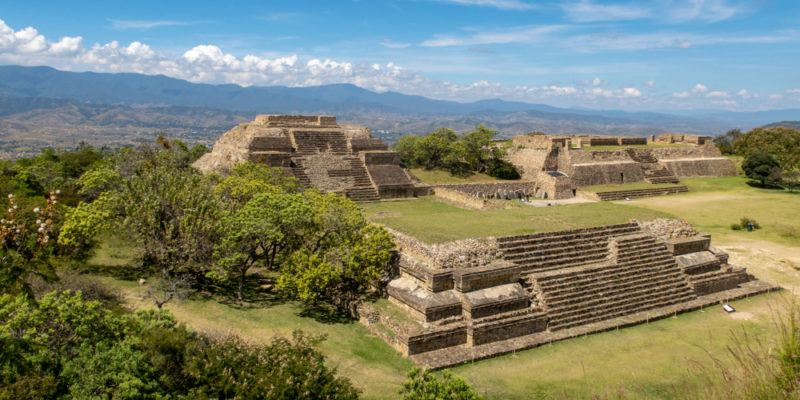
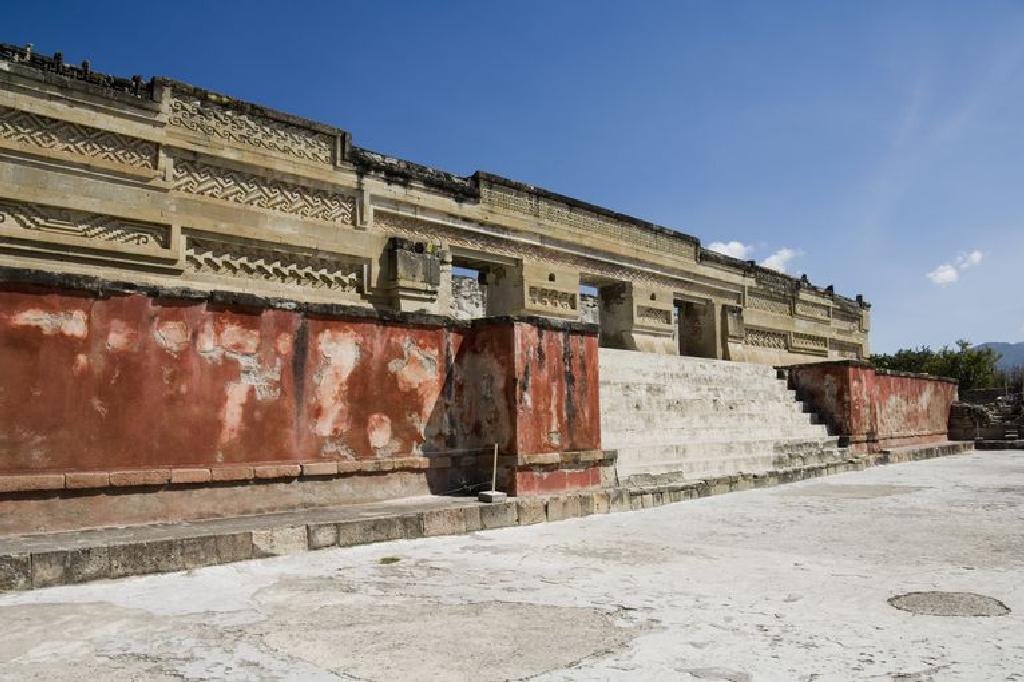

History
Historical Notes about the Mixtec: Pre-Hispanic times through the Conquest
Much about the Mixteca’s pre-history is unknown, but archaeologists agree there were small farming settlements in the region by 1500 BCE. These communities grew and expanded in number so that by the period 500-750 CE there were socially stratified, urban centers. These early societies developed monumental architecture, a calendar, terrace farming, irrigation systems, and glyphic writing (Bartolomé, 1999; Carrasco, 2001).
The 10th century marked the emergence of Mixtec kingdoms, called “señorios” by the Spanish. The señorios were founded on marriage and political alliances which led to the formation of dynasties. Señorios were hierarchical in structure and included classes of greater and lesser nobles, artisans and peasants.
The first reference to Mixtec dynasties appear in the codexes1 from the 10th century. One of the greatest of the Mixtec dynasties was the Tilantongo dynasty, established upon the marriage of two nobles in the holy Mixtec city of Tilantongo in 990CE. The Tilantongo dynasty ruled until the 17th century. One of its most illustrious descendants was 8 Venado, Garra de Jaguar (8 Deer, Jaguar’s Paw, 1053-1115 CE). Several of the codexes tell his story. 8 Venado, Garra de Jaguar became lord of both Tilantongo, in the Mixteca Alta and Tututepec, on the coast, locations separated by a distance of 200 kilometers. He is hailed for having united the entire Mixteca region through battle, alliances and palace intrigues (Bartolomé, 1999).
More:
https://mixtec.sdsu.edu/history.html
. . .

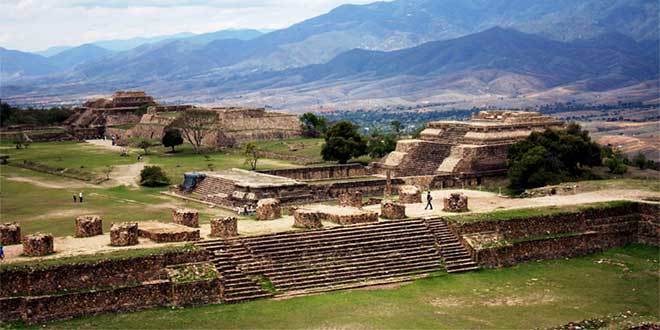

Sunday, 30 October 2016
Zapotec Empire of Central America
The Zapotec civilization was an indigenous pre-Columbian civilization(700 BC - 1521 AD) that flourished in the Valley of Oaxaca in Central America in present day Mexico. Archaeological evidence shows that their culture goes back at least 2,500 years.
The Zapotec left archaeological evidence at the ancient city of Monte Albán in the form of buildings, ball courts, magnificent tombs and grave goods including finely worked gold jewelry. Monte Albán was one of the first major cities in Mesoamerica and the center of a Zapotec state that dominated much of the territory that today belongs to the Mexican state of Oaxaca.
The Mesoamerican ballgame was a sport with ritual associations played since 1,400 BC by the pre-Columbian peoples of Ancient Mesoamerica. The sport had different versions in different places during the millennia, and a newer more modern version of the game, ulama, is still played in a few places by the indigenous population.
The Zapotec languages belong to a language family called Oto-manguean, an ancient family of Mesoamerican languages. It is estimated that today's Oto-manguean languages branched off from a common root at around 1500 BC. Zapotec is a tone language, which means that the meaning of a word is often determined by voice pitch, essential for understanding the meaning of different words. The Zapotec languages features up to 4 distinct tonemes: high, low, rising and falling.
More:
http://www.humanhistoryinbrief.net/2016/10/zapotec-empire-of-central-america.html
Grenada: Confronting my family's slave-owning past
By Laura Trevelyan
BBC News, Grenada
Published3 hours ago

Nicole Phillip-Dowe, DC Campbell and Laura Trevelyan explore a former slave plantation on Grenada
Nearly 200 years after her ancestors were given a large payout from the British government when slavery was abolished, our correspondent travels to Grenada to find out how this grim legacy continues to reverberate today.
_ _ _ _ _ _
High up in the hills of the Caribbean island of Grenada, in the grounds of a former slave plantation, a cast iron bell hangs from a tree.
The ringing of the bell signified the start of another working day for West African slaves, harvesting sugar cane. Today, the Belmont estate is a popular destination for tourists. It's a place to enjoy the local cuisine and visit the gift shop, where you can buy artisanal chocolate bars embossed with the image of the slave bell.
It was here that I came face to face with the brutality of the past - and the role played by families like mine.
"This is the sound of slavery," said DC Campbell, a Grenadian novelist and descendent of slaves. He picked up a pair of shackles made for a child, turning them over in his hands.
More:
https://www.bbc.com/news/world-latin-america-61315877
Investigation Shows Hundreds of US Cops Being Trained by Far-Right Extremists

Police officers pepper spray a woman next to the Colorado State Capitol as protests against the killing of George Floyd continue on May 30, 2020 in Denver, Colorado. (Photo: Michael Ciaglo/Getty Images)
"Bad training is instilling bad behavior," said one criminal justice reform advocate.
KENNY STANCIL
May 6, 2022
Hundreds of cops across the United States have been taught by individuals who espouse far-right extremist views, according to a new investigation that was published Friday to sound the alarm on a burgeoning and unregulated private training industry.
Reuters identified five law enforcement trainers who have been hired by police and sheriffs' departments nationwide despite their support for right-wing militia groups, including the Oath Keepers, Proud Boys, and Three Percenters; the QAnon conspiracy, which baselessly claims that Democrats and Hollywood stars belong to a cabal of Satanist pedophiles and cannibals; and former President Donald Trump's "Big Lie" that the 2020 election was stolen.
Some use bigoted instructional materials that promote racism, misogyny, and transphobia, and many endorse the constitutional sheriff philosophy, which maintains that county sheriffs should refuse to uphold any law they find unconstitutional.
"Adherents to the constitutional sheriff movement consider the federal government a grave threat to U.S. citizens," Reuters reported. "They argue that local law enforcement is a higher authority, with the power to countermand the decisions of legislatures, courts, and presidents."
Richard Whitehead, one of dozens of active and retired police officers or trainers who were listed in a database of members of the Oath Keepers, "has called for public executions of government officials he sees as disloyal" to Trump, Reuters reported. In a 2020 social media post, he urged cops "to disobey Covid-19 public-health orders from 'tyrannical governors,' adding: 'We are on the brink of civil war.'"
More:
https://www.commondreams.org/news/2022/05/06/investigation-shows-hundreds-us-cops-being-trained-far-right-extremists
Our work is licensed under Creative Commons (CC BY-NC-ND 3.0). Feel free to republish and share widely.
'Enforced childbirth is slavery': Margaret Atwood on the right to abortion
The US supreme court draft ruling on abortion is an assault on fundamental individual freedoms. The Handmaid’s Tale author reflects on the issues at stake
Sat 7 May 2022 02.00 EDT
Nobody likes abortion, even when safe and legal. It’s not what any woman would choose for a happy time on Saturday night. But nobody likes women bleeding to death on the bathroom floor from illegal abortions either. What to do?
Perhaps a different way of approaching the question would be to ask: What kind of country do you want to live in? One in which every individual is free to make decisions concerning his or her health and body, or one in which half the population is free and the other half is enslaved?
Women who cannot make their own decisions about whether or not to have babies are enslaved because the state claims ownership of their bodies and the right to dictate the use to which their bodies must be put. The only similar circumstance for men is conscription into an army. In both cases there is risk to the individual’s life, but an army conscript is at least provided with food, clothing, and lodging. Even criminals in prisons have a right to those things. If the state is mandating enforced childbirth, why should it not pay for prenatal care, for the birth itself, for postnatal care, and – for babies who are not sold off to richer families – for the cost of bringing up the child?
And if the state is very fond of babies, why not honour the women who have the most babies by respecting them and lifting them out of poverty? If women are providing a needed service to the state – albeit against their wills – surely they should be paid for their labour. If the goal is more babies, I am sure many women would oblige if properly recompensed. Otherwise, they are inclined to follow the natural law: placental mammals will abort in the face of resource scarcity.
More:
https://www.theguardian.com/us-news/2022/may/07/enforced-childbirth-is-slavery-margaret-atwood-on-the-right-to-abortion
Why the US War on Cuba?
MAY 6, 2022
BY JACOB G. HORNBERGER
. . .
Oh, sure, one can argue that a brutally enforced economic embargo by the most powerful regime in history against one of the smallest, most impoverished nations in the world isn’t aggression, but you’d have a hard time convincing the Cuban people of that. Ever since the U.S. embargo was imposed on Cuba more than sixty years ago, the Cuban people have suffered severe economic privation because of it.
Yes, I know, Cuba’s socialist economic system has also been a factor in the impoverishment of Cuba. But that doesn’t necessarily mean that the U.S. embargo hasn’t also been a major factor in their impoverishment. The fact is that for more than six decades, the Cuban people have been squeezed between an evil vise, with one side of the vise being socialism and the other side of the vise being the U.S. economic embargo, which, ironically, are both based on the same principle: government control over people’s economic activity.
Make no mistake about it: the purpose of the U.S. embargo is to kill Cuban citizens by depriving them of items essential for survival. Absent killing them, the goal is to make them as poor as possible. The idea is that if Cubans are dying or suffering extreme poverty, they will rise up, oust their ruling regime, and replace it with a pro-U.S. dictatorship, one that would be absorbed into the U.S. Empire and do the bidding of the Pentagon and the CIA.
The big question — the question that every single American should be asking — is: Why? What have the Cuban government and the Cuban people ever done to the United States to warrant this brutal U.S. aggression?
More:
https://www.counterpunch.org/2022/05/06/why-the-us-war-on-cuba/
THE TIME THE CIA OVERTHREW THE GOVERNMENT IN GUATEMALA
BY CHANDLER STARK/MAY 1, 2022 5:39 PM EDT
The CIA has a much maligned reputation in 2022. Between revelations about secret torture files, unauthorized spying on American citizens, secret mind control experiments, and their shady involvement in the JFK assassination, the CIA has seemingly been associated with an endless stream of scandals. President Harry S. Truman originally created the CIA in September 1947 as part of the National Security Act, in order to coordinate intelligence efforts among all U.S. government agencies (per the Truman Library). The CIA was the final successor to the Office of Strategic Services (OSS), a secret intelligence and covert operations agency that functioned in Europe during WWII.
The agency, however, quickly morphed from just intelligence gathering and espionage to full blown participation in revolutions and regime changes. In 1953, the CIA orchestrated the overthrow of the Iranian Prime Minister Mohammed Mossadegh, and in 1960 they aided Congolese militants in the execution of Patrice Lumumba (via ForeignPolicy.org).
Sandwiched between these coups was the forced regime change in Guatemala, where in 1954, the CIA played a pivotal role in the ousting of President Juan Jacobo Árbenz Guzmán. The American role in the bloody coup was suppressed from American audiences for years, and even today the full story is probably not completely known. A depressing and embarrassing moment in American foreign policy, this is the time the CIA overthrew the Guatemalan government.
THE 1945 GUATEMALAN REVOLUTION
A decade before the coup, and before the CIA even existed as an organization, the 1945 Guatemalan Revolution occurred. According to Walter LaFeber in "Inevitable Revolutions: The United States in Central America," in the 1930s and early 1940s, the dictator Jorge Ubico ruled Guatemala through a corrupt and repressive system. Elections were rigged and there was little done for the social and economic welfare of the majority of the nation's impoverished citizens. The revolution was led by college students and younger army officers, and they immediately held free elections which brought former teacher Juan José Arévalo to the presidency. Arévalo considered himself a "spiritual socialist," and he considered both Marxism and capitalism to be flawed.
Read More: https://www.grunge.com/849295/the-time-the-cia-overthrew-the-government-in-guatemala/?utm_campaign=clip
~ ~ ~

dictator Jorge Ubico
. . . . . . . .


Juan Jacobo Árbenz Guzmán
~ ~ ~
The Guatemalan Government’s Apology for the 1954 Coup
WIRTZ AND KARA ANDRADE | NOVEMBER 1, 2011
On October 20, the day of Guatemala’s revolution, the country’s government formally apologized to the family of former President Juan Jacobo Arbenz Guzmán, who was deposed in a coup in 57 years ago.
“I want to apologize to the family for the great crime committed on June 27, 1954,” said President Alvaro Colom at the National Palace in Guatemala City. “A crime committed against the former president, his wife, his family. It was a historic crime for Guatemala—that day changed Guatemala and we have not recuperated from it since.”
It was a small ceremony held on a national public holiday to celebrate Revolution Day and only a few weeks before the second round of the election this weekend. In attendance were Jacobo Arbenz Vilanova, son of the ex-president, the government’s cabinet, diplomats, national institutions, and, the list of people presented by the family.
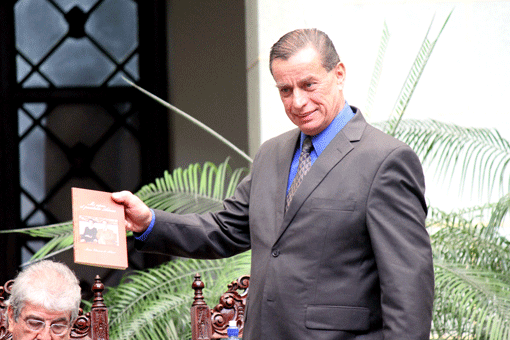
Jacobo Arbenz Vilanova, son of the former president, receives the book
Mi Esposo el Señor Presidente, a biography written by his mother, María
Vilanova. Photo courtesy of Kara Andrade.
“There was no intentionality election-wise or because it’s the end of the government,” said Dora Ruth del Valle Cóbar, president of Centro de Comunicación y Prensa Alternativa para el Desarrollo Humano (COPADEH). “It’s our responsibility and since it’s the first 20th of October that we have after signing the agreement with the victims.”
More:
https://www.americasquarterly.org/blog/the-guatemalan-governments-apology-for-the-1954-coup/
Will Washington's favored candidate prevail in tight Colombia race?
Conservative Fico Gutiérrez’s popularity with the U.S. may not help him against popular leftist Gustavo Petro.
APRIL 22, 2022
Written by
Adam Isacson
Both the Trump and Biden administrations had an easy relationship with the deeply conservative government that has ruled Colombia since 2018.
U.S. officials, who call Iván Duque’s Colombia “a keystone of the region,” have been more content with the 45-year-old president’s performance than most Colombians, who give him a mere 20-percent approval rating. Duque’s four years come to an end in August, and Colombia will elect a new president on May 29, with a second, run-off round on June 19.
This will be one of the most consequential and contested elections ever for Latin America’s third-largest country. The result will have major implications for the U.S. government, which has given Colombia more than $13 billion in assistance so far this century, far more than for any other country in the hemisphere.
Head-to-head second-round scenario polling shows a razor-thin margin between the two leading candidates, who represent dramatically different visions of government. Federico “Fico” Gutiérrez, a former Medellín mayor, offers continuity with Duque’s conservative politics, which the Biden administration might find reassuring. It would, however, mean continuity with a model of which most Colombians appear to disapprove after four years of worsening violence and economic insecurity.
More:
https://responsiblestatecraft.org/2022/04/22/how-the-upcoming-elections-in-colombia-will-impact-us-regional-policy/
Profile Information
Member since: 2002Number of posts: 160,631